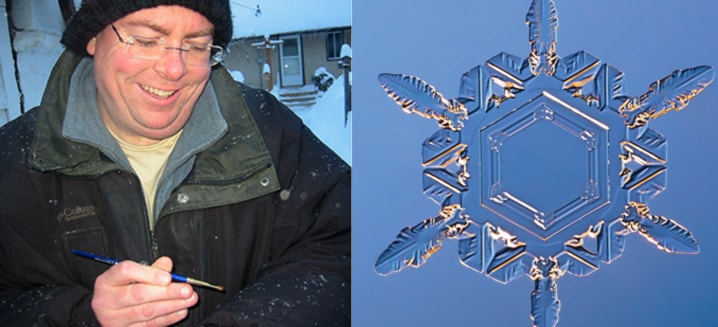EDMONTON — It began in the familiar drudgery of shovelling the walk. It ended in the discovery of fleeting and delicate beauty right underfoot.
“Snowflakes are such temporary pieces of art,” says Edmonton photographer Paul Burwell, who now waits all winter for just the right storm so he can create his detailed and radiantly lit images of snow crystals.
“When you do take a closer look and the conditions are right, the magical quality of what is created out of nothing is spectacular.”
Burwell, 46, is primarily an animal photographer. But in an Edmonton winter, “there isn’t a whole lot of wildlife.”
One deep-freeze day three years ago, he was thinking about winter subjects as he shovelled snow off his sidewalk.
Then he looked down at the dark-coloured sleeve on his parka.
“This time, for whatever reason, I paid closer attention to whatever was there, to the intricate forms and shapes of the snowflakes. And I thought, ’Wow, I wonder if there was a way I could photograph it and make it into art?’
“That’s where the journey began.”
It took some time and some advice, but Burwell figured it out.
The images begin with the right kind of snow, produced only on nights between -10 and -18 C. and with as little wind as possible. Burwell stands in his backyard, holds out his arm and watches flakes fall on that same parka sleeve.
When he spots something likely-looking, he picks it off his parka with a paintbrush.
“Certain features just jump out at me,” Burwell said. “There’s some snowflakes especially that have these jewels at their centre when they’re lit right. Those are the ones I go after.”
Burwell then heads into his “snowflake studio,” a.k.a. his unheated garage.
He carefully flicks the flake onto a clear glass plate fixed under the business end of a stand-mounted camera pre-rigged with magnifiers, extension tubes, flash units and colourful light reflectors.
Burwell has about two minutes to shoot his specimen before it either melts or simply disappears. It’s time enough for two or three different lighting blends.
When conditions are right, Burwell stays out for hours. Eventually, his wife has to lean out the back door and call him in.
Success is rare. On a good night, Burwell says he’ll shoot 500 pictures. Since 2008, he figures he’s shot tens of thousands of snowflakes.
His gallery of “showflakes,” however, only has about 40 images.
“If I can get one or two out of a snowstorm, I’m thrilled.”
And, no, he’s never seen two the same. Asked what photographing snowflakes has done for him, Burwell’s answer could be a New Year’s resolution.
“Just, wonderment,” he says. “Before I started this work, I would take (snow) for granted, especially living here. But now I look at it totally, totally differently.
“It helps me slow down and appreciate the world for what it is.”
